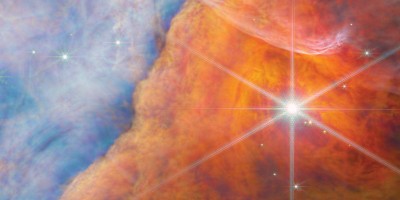Observations using JWST show water, probably from a subsurface ocean on Saturn’s icy moon, spewing into a large plume that extends far beyond the moon’s surface. This continuous outgassing results in a torus of water along Enceladus’s orbit and is so intense that the plume is the prime source of water across the Saturnian system.

References
Iess, L. et al. The gravity field and interior structure of Enceladus. Science 344, 78–80 (2014). This paper, based on Doppler data from spacecraft flybys, indicates a regional subsurface sea in Enceladus, at depths of 30–40 km and extending up to southern latitudes.
Porco, C. C. et al. Cassini observes the active south pole of Enceladus. Science 311, 1393–1401 (2006). This article presents Cassini measurements that confirmed the existence and regionally confined nature of a water-vapour plume in the south polar region of Enceladus.
Cassidy, T. A. & Johnson, R. E. Collisional spreading of Enceladus’ neutral cloud. Icarus 209, 696–703 (2010). This paper presents a Monte Carlo simulation of Enceladus’s neutral cloud and its comparison to observations of OH and O orbiting Saturn. Enceladus may be the ultimate source of oxygen for the upper atmospheres of Titan and Saturn.
Hansen, C. J. et al. The composition and structure of Enceladus’ plume from the complete set of Cassini UVIS occultation observations. Icarus 344, 113461 (2020). This paper describes the observations and analysis of all of the Enceladus occultations observed by Cassini’s Ultraviolet Imaging Spectrograph, and other observations designed to study the plume.
Hartogh, P. et al. Direct detection of the Enceladus water torus with Herschel. Astron. Astrophys. 532, L2 (2011). This paper reports measurements of Enceladus’s water torus by the Herschel Space Observatory.
Additional information
Publisher’s note Springer Nature remains neutral with regard to jurisdictional claims in published maps and institutional affiliations.
This is a summary of: Villanueva, G. L. et al. JWST molecular mapping and characterization of Enceladus’ water plume feeding its torus. Nat. Astron. https://doi.org/10.1038/s41550-023-02009-6 (2023).
Rights and permissions
About this article
Cite this article
The immense water plume of Enceladus and its torus have been captured by JWST. Nat Astron 7, 1017–1018 (2023). https://doi.org/10.1038/s41550-023-02010-z
Published:
Issue Date:
DOI: https://doi.org/10.1038/s41550-023-02010-z
- Springer Nature Limited


